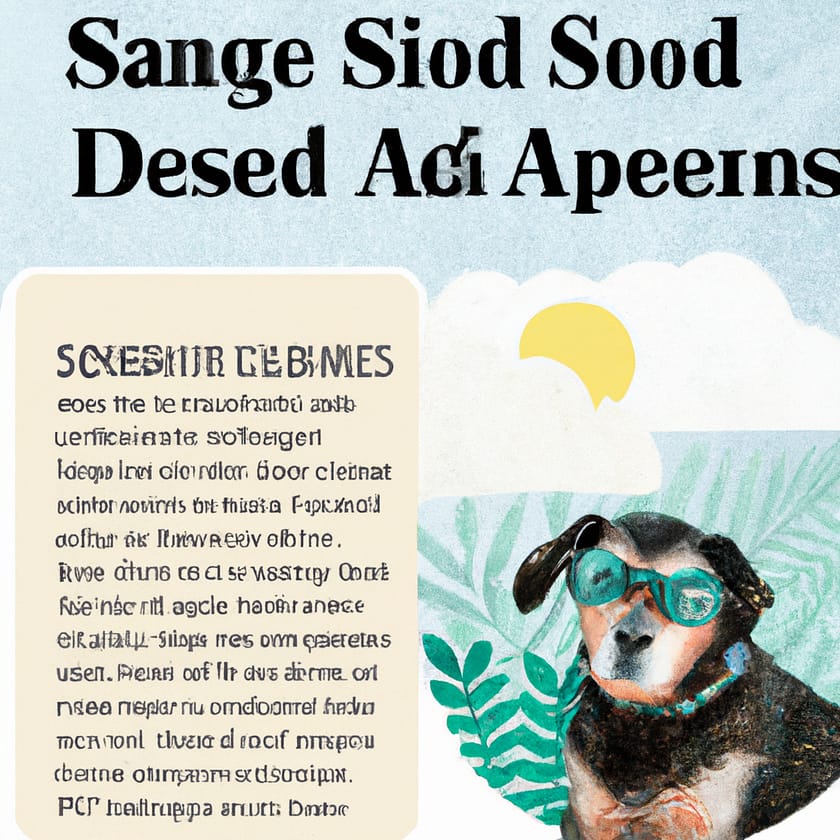SARDS In Dogs: How To Help Your Pup With Sudden Vision Loss
If your furry companion has recently been diagnosed with Sudden Acquired Retinal Degeneration Syndrome (SARDS), a condition that can cause sudden and complete vision loss in dogs, you may be feeling overwhelmed and unsure of how to support them through this difficult time. In this article, we will explore some practical ways you can help your pup adjust to their visual impairment, from creating a safe and familiar environment to providing additional support and reassurance. With some understanding and a little extra care, you can make a big difference in your dog’s life as they navigate this new chapter.

Understanding SARDS in Dogs
When your beloved furry friend begins to experience sudden vision loss, it can be a distressing and confusing time. One possible cause for this condition is SARDS, which stands for Sudden Acquired Retinal Degeneration Syndrome. In this article, we will explore what SARDS is, its possible causes, common symptoms, and how it can be diagnosed.
What is SARDS?
Sudden Acquired Retinal Degeneration Syndrome, or SARDS, is a condition that affects dogs, leading to the rapid and irreversible loss of vision. It occurs when the cells in the retina, which is responsible for processing visual information, begin to degenerate. While the exact cause of SARDS is still unknown, it is believed to result from an autoimmune response that targets the retinal cells. This condition typically affects middle-aged to older dogs, and certain breeds, such as Dachshunds and Miniature Schnauzers, may be more prone to developing SARDS.
Causes of SARDS
While the precise cause of SARDS is yet to be determined, researchers speculate that it may be related to an autoimmune response. The immune system mistakenly attacks the retina, leading to inflammation and subsequent degeneration of the retinal cells. Other potential factors, such as hormonal imbalances and genetics, may also contribute to the development of SARDS. However, further research is needed to fully understand the underlying causes of this condition.
Symptoms of SARDS
Identifying the symptoms of SARDS is crucial for prompt diagnosis and intervention. Some common signs that your dog may be experiencing sudden vision loss due to SARDS include a noticeable decrease in visual responsiveness, bumping into furniture or walls, difficulty navigating previously familiar surroundings, dilated pupils that don’t respond to light, and a sudden change in behavior or increased anxiety. It’s important to note that these symptoms can also be indicative of other eye or health conditions, so consulting with a veterinarian is essential for an accurate diagnosis.
Diagnosing SARDS
Accurate diagnosis of SARDS usually involves a combination of physical examinations, veterinary ophthalmology assessments, and specialized tests. Your veterinarian will conduct a thorough examination of your dog’s eyes, looking for signs of retinal degeneration. Several tests, such as electroretinogram (ERG) and bloodwork, may be performed to confirm the diagnosis. These tests can determine the functionality of the retina and rule out other potential causes of vision loss. Prompt veterinary intervention and diagnosis are crucial for providing the necessary care and support for your visually impaired dog.
Living with a Visually Impaired Dog
Discovering that your furry companion is visually impaired can be a challenging adjustment for both you and your pet. However, with some modifications to your daily routines and the creation of a safe environment, you can help your dog lead a fulfilling and happy life. Let’s explore some practical tips to assist you in supporting your visually impaired dog.
Creating a Safe Environment
Ensuring that your home is safe and accessible for your visually impaired pup is essential. Consider removing any tripping hazards, such as clutter or loose rugs, and securing furniture to prevent accidents. Placing baby gates in certain areas of the house can help control your dog’s movements and keep them away from potentially dangerous areas. Additionally, using scent markers or audible cues can help your dog navigate the environment.
Assisting with Navigation
Helping your visually impaired dog navigate their surroundings is key to their independence and confidence. One effective way to assist them is by establishing consistent routes within your home and yard. This way, your pup can rely on their memory and develop a mental map of their environment. You can also use verbal cues and touch to guide them safely, especially when approaching staircases or uneven surfaces.
Modifying Daily Routines
Modifying your daily routines can greatly facilitate your visually impaired dog’s adjustment. Keep their food and water bowls in the same location to help them locate them easily. Avoid moving furniture or rearranging the layout of your home as this can cause confusion. Using specific scents or cues to indicate specific activities, such as playtime or going for a walk, can also help your dog understand and anticipate their daily routines.
Communication and Training
Effective communication and consistent training are vital when living with a visually impaired dog. Using verbal cues and hand signals can help your pup understand commands, and reward-based training methods can reinforce positive behaviors. Be patient, understanding, and consistent in your interactions. With time and practice, your visually impaired dog can learn new commands and adapt to their changed circumstances.
Medical Treatment for SARDS
While there is currently no cure for SARDS, various medical treatments can help manage the symptoms and improve your dog’s quality of life. It is crucial to consult with a veterinarian experienced in ophthalmology to develop the most appropriate treatment plan for your dog. Let’s explore some common medical treatments used for SARDS.
Consulting with a Veterinarian
Consulting with a veterinarian who specializes in ophthalmology is essential when dealing with SARDS. These professionals have the necessary expertise to diagnose and manage the condition effectively. Regular check-ups and examinations can help monitor your dog’s progress and ensure any changes in their condition are addressed promptly.
Exploring Medication Options
Medication may be prescribed by your veterinarian to manage symptoms associated with SARDS. Prednisone, a corticosteroid, is commonly used to reduce inflammation and suppress the autoimmune response that contributes to the degeneration of retinal cells. Other medications, such as immunosuppressants or antioxidants, may also be utilized to support your dog’s eye health and overall well-being.
Surgical Procedures
In some cases, surgical interventions may be recommended to address specific complications associated with SARDS. For example, if your dog develops cataracts as a result of the condition, cataract removal surgery may be necessary to improve their vision. However, it is important to discuss the potential risks and benefits of surgery with your veterinarian, as individual circumstances can vary.
Alternative Therapies
Additionally, complementary and alternative therapies can be beneficial in managing SARDS symptoms. Acupuncture, massage, and hydrotherapy are among the alternative therapies that can help alleviate discomfort, improve circulation, and promote relaxation in your visually impaired dog. Always consult with your veterinarian before trying any alternative therapies to ensure they are safe and appropriate for your dog’s specific needs.
Diet and Nutrition for Dogs with SARDS
Proper nutrition plays a vital role in supporting your visually impaired dog’s overall health and well-being. Ensuring they receive a balanced diet, selecting the right food, considering supplements for eye health, and managing changes in appetite are crucial elements to consider when designing a dietary plan for your pup.
Importance of a Balanced Diet
Providing a balanced and nutritious diet is essential in maintaining your dog’s overall health and supporting their eyes’ well-being. A well-rounded diet should consist of high-quality, easily digestible protein sources, healthy fats, and a variety of fruits and vegetables. Ensuring your dog receives essential vitamins, minerals, and antioxidants can help support their immune system and potentially slow down the progression of retinal degeneration.
Choosing the Right Food
When selecting a food for your visually impaired dog, consider their individual nutritional needs and any specific health concerns they may have. Opt for a reputable brand that offers formulas specially designed for dogs with visual impairments or senior dogs. These formulas often contain essential fatty acids, antioxidants, and ingredients that support overall eye health.
Supplements for Eye Health
Supplements can also play a role in supporting your dog’s eye health. Omega-3 fatty acids, such as fish oil, are known for their anti-inflammatory properties and potential benefits for retinal health. Additionally, antioxidants like vitamins C and E can help protect the eyes from oxidative stress. However, it is essential to consult with your veterinarian before introducing any supplements to ensure they are safe and appropriate for your dog.
Handling Changes in Appetite
It is not uncommon for dogs with SARDS to experience changes in appetite. Some may lose interest in food, while others may experience increased hunger due to hormonal imbalances. Monitor your dog’s eating habits and consult with your veterinarian if you notice any significant changes. They can provide guidance on adjusting the feeding schedule, portion sizes, or recommend specific diets tailored to your dog’s individual needs.

Supportive Care for Dogs with SARDS
Providing ongoing supportive care is crucial in helping your visually impaired dog adapt to their new normal. Regular veterinary check-ups, managing other health conditions, offering emotional support, and joining support groups can all contribute to your dog’s well-being.
Regular Veterinary Check-ups
Regular veterinary check-ups are essential in monitoring your dog’s overall health and addressing any changes in their condition. Your veterinarian can perform comprehensive examinations and recommend any necessary adjustments to their treatment plan, ensuring your pup receives the best possible care.
Managing Other Health Conditions
Many dogs with SARDS may have concurrent health issues that require extra attention. For example, hormonal imbalances, such as Cushing’s disease, are sometimes associated with SARDS. By effectively managing these additional health conditions, you can help improve your dog’s overall well-being, potentially slowing down the progression of SARDS.
Emotional Support for Your Dog
Dealing with sudden vision loss can be emotionally challenging for your dog. Providing them with emotional support, patience, and reassurance as they navigate their new reality is important. Ensure they feel safe and loved by maintaining a consistent routine, offering comforting physical touch, and engaging in activities they enjoy.
Joining Support Groups
Connecting with others who have gone through similar experiences can provide valuable emotional support for both you and your dog. Online support groups or local meet-ups with other visually impaired dog owners can serve as a source of encouragement, shared knowledge, and practical tips for navigating life with a visually impaired pup.
Assistive Devices for Blind Dogs
Assistive devices can greatly enhance the quality of life for visually impaired dogs, allowing them to navigate their environment more easily and independently. Harnesses and leashes, protective gear for outdoor activities, visual aids, and specialized toys are among the many options available to support your blind pup.
Harnesses and Leashes
Using a harness rather than a traditional collar can provide better support and prevent injury to your visually impaired dog’s neck. A harness allows for better control and guiding capabilities, making walks and outdoor adventures safer for both of you. Additionally, opt for a leash that is resistant to tangling, allowing for smoother navigation and increased mobility.
Protective Gear for Outdoors
When engaging in outdoor activities, protective gear can help prevent accidents and injuries. Consider using boots or paw protectors to shield your dog’s paws from sharp objects or harsh surfaces. Reflective vests or collars can also provide increased visibility, especially during nighttime walks or in low-light settings.
Visual Aids and Toys
Visual aids specifically designed for blind dogs, such as blind dog halo vests or sensory warning devices, can greatly assist your visually impaired pup in navigating their environment. These aids can help them detect obstacles and avoid potential hazards. Additionally, selecting toys with sounds, textures, or scents can provide mental stimulation and entertainment for your furry friend.
Training for Using Assistive Devices
It is important to introduce assistive devices gradually and provide training sessions to ensure your dog becomes comfortable and confident in using them. Positive reinforcement training methods can be effective in teaching your dog how to respond to and utilize these devices. Patience and consistency are key in helping your dog adapt to assistive devices and achieve independence.

Common Challenges and Solutions
Living with a visually impaired dog presents unique challenges. However, with patience, understanding, and some adaptive strategies, you can overcome these obstacles and ensure your dog’s well-being and quality of life.
Coping with Anxiety and Fear
Sudden vision loss can understandably lead to anxiety and fear in your pup. Establishing a safe and predictable routine, providing plenty of positive reinforcement, and offering reassurance and affection can help alleviate these emotional challenges. Consulting with a professional dog behaviorist or trainer may also provide valuable guidance in addressing anxiety and fear-related issues.
Addressing Changes in Behavior
Visually impaired dogs may exhibit changes in behavior as they adapt to their new circumstances. They may become more cautious, clingy, or exhibit signs of frustration. Patience, consistency, and positive reinforcement training can help address these changes. Consult with your veterinarian or a professional dog trainer for additional guidance and support.
Dealing with Night Blindness
Night blindness, or the inability to see in low-light conditions, is a common challenge faced by visually impaired dogs. Minimize the risk of accidents by ensuring your home is well-illuminated during nighttime. Consider using night lights or motion sensor lights to help your dog navigate safely in the dark. Avoid sudden changes in lighting as it can further disorient your pup.
Managing Household Hazards
Creating a safe home environment is crucial in protecting your visually impaired dog from potential hazards. Secure loose electrical cords, block off access to stairs or swimming pools, and cover sharp corners on furniture. Use baby gates or barriers to prevent access to areas that may be dangerous for your dog. Regularly inspect your home for any potential hazards and address them promptly.
Living a Fulfilling Life with SARDS
While adjusting to life with a visually impaired dog may present initial challenges, it is important to remember that your furry friend can still lead a fulfilling and happy life. Here are some suggestions to help you and your visually impaired dog navigate this new chapter together.
Adapting Activities and Play
Adapting activities and playtime to suit your visually impaired dog’s needs is essential for their physical and mental well-being. Engage in interactive play with them using toys that stimulate other senses, such as hearing or scent. Puzzle toys and treat-dispensing toys can provide mental stimulation and entertainment. Additionally, consider exploring new activities that focus on your dog’s other senses, such as scent work or basic obedience training.
Enriching Your Dog’s Environment
Enriching your dog’s environment can help keep them mentally stimulated and engaged. Provide a variety of toys that appeal to different senses, such as squeaky toys, toys with different textures, or toys that emit sounds. Rearranging furniture or adding new scents and textures to their environment can also provide novel and enriching experiences for your visually impaired companion.
Encouraging Mental Stimulation
Promoting mental stimulation is essential in keeping your visually impaired dog engaged and mentally sharp. Incorporate puzzle toys, food-dispensing toys, and interactive games into their daily routine. Teaching them new commands or tricks during training sessions can also provide mental exercise and further bond with your pup.
Maintaining a Healthy Lifestyle
Maintaining overall health and well-being is crucial for your visually impaired dog’s quality of life. Regular exercise, a balanced diet, and routine veterinary check-ups are important components of a healthy lifestyle. Prioritize your dog’s physical and mental health to help them lead a fulfilling life despite their visual impairment.

SARDS and Your Dog’s Quality of Life
When living with a visually impaired dog, striking a balance between independence and support is key to ensuring their overall quality of life. By monitoring various indicators and making informed decisions, you can help your dog live a comfortable and joyful life.
Balancing Independence and Support
Finding the right balance between allowing your visually impaired dog to explore independently and providing support is essential. Offer assistance when needed, such as guiding them in unfamiliar environments or avoiding potential hazards. However, encourage and allow them to navigate familiar areas independently to maintain their confidence and sense of freedom.
Monitoring Quality of Life Indicators
Regularly monitoring your visually impaired dog’s quality of life is crucial to ensure they are comfortable and happy. Keep an eye out for changes in behavior, eating patterns, or mobility. If you notice any significant changes or signs of discomfort, consult with your veterinarian to assess and address any potential underlying issues.
Making End-of-Life Decisions
As a pet owner, making end-of-life decisions can be heartbreaking but necessary when your visually impaired dog’s quality of life declines. Consult with your veterinarian to discuss your dog’s individual circumstances, prognosis, and available options. Their expertise and guidance can assist you in making the most compassionate and informed decisions for your beloved companion.
Euthanasia Considerations
Although a difficult topic to discuss, euthanasia may be a consideration for your visually impaired dog if their quality of life deteriorates significantly. When faced with this decision, consult with your veterinarian to ensure your dog’s well-being and comfort are prioritized. They can guide you through the process, providing support and empathy during this challenging time.
The Emotional Impact on Dog Owners
Coping with the diagnosis of SARDS and its effects on your dog’s vision can have a significant emotional impact on dog owners. Understanding and managing your own emotions is crucial as you navigate this journey alongside your visually impaired pup.
Coping with the Diagnosis
Receiving a diagnosis of SARDS for your beloved pet can be emotionally overwhelming. It is normal to experience a range of emotions, including sadness, frustration, and even guilt. Allow yourself time to process these emotions and seek support from loved ones, friends, or support groups. Remember that you are not alone in this journey.
Seeking Emotional Support
Seeking emotional support is essential when dealing with the challenges of living with a visually impaired dog. Reach out to friends, family, or other dog owners who have gone through similar experiences. Online communities and support groups can also provide a sense of understanding, empathy, and practical advice.
Managing Guilt and Frustration
Feelings of guilt and frustration are common for dog owners when their pets are diagnosed with SARDS. Recognize that these emotions are normal but try to focus on providing the best possible care and support for your dog. Remind yourself that you are doing everything you can to ensure their well-being and happiness.
Embracing the Journey
While the diagnosis of SARDS may bring challenges, it can also present opportunities for growth and connection with your visually impaired dog. Embrace the journey and the unique bond that can develop as you navigate this new chapter together. Be patient, compassionate, and open to learning from your furry friend’s resilience and adaptability.
Living with a visually impaired dog due to SARDS may require adjustments and additional care, but it does not diminish the love and joy that your furry friend brings to your life. By understanding the condition, providing necessary support, and embracing the journey, you can ensure your dog’s well-being and make the most of the special bond you share.













